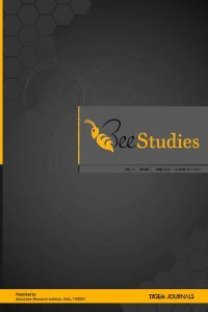A Preliminary Study for the Application of ISSR Markers to Discriminate Honey Bee (Apis mellifera L.) Populations in Turkey
Potential of Inter Simple Sequence Repeats (ISSR) markers in analyzing and discriminating of Turkish honeybee populations was assessed in this study. Genomic DNA samples of workers belonging to four subspecies and two ecotypes of honey bees were amplified by PCR using 5 microsatellite primers. Principal component and population structure analyses showed that ISSR method successfully defined and discriminated four distinct Turkish honeybee subspecies while the two ecotypes of Anatoliaca subspecies were not distinctively separated from each other. This study showed that ISSR markers can be a simple and low-cost alternative with high resolution compared to other markers such as microsatellite and RAPD, in analyzing the genetic variations in Turkish honey bee subspecies.
___
- Al-Otaibi, S. A. (2008). Genetic variability in mite-resistant honey bee using ISSR molecular markers. Arab Journal of Biotecnology, 11, 241-252.
- Bodur C, Kence M, & Kence A. (2007). Genetic structure of honeybee, Apis mellifera L. (Hymenoptera:Apidae) populations of Turkey inferred from microsatellite analysis. Journal of Apicultural Research 46(1), 50-56.
- Bouga, M., Kilias, G., Harizanis, P. C., Papastiropoulos, V., Alahiotis, S. (2005a). Allozyme variability and phylogenetic relationships in honey bee (Hymenoptera: Apidae: A. mellifera) populations from Greece and Cyprus. Biochemical Genetics, 43, 471-484
- Bouga, M., Harizanis, P. C., Kilias, G., Alahiotis, S. (2005b). Genetic divergence and phylogenetic relationships of honey bee Apis mellifera (Hymenoptera: Apidae) populations from Greece and Cyprus using PCR - RFLP analysis of three mtDNA segments. Apidologie, 36, 335-344.
- Cánovas, F., de la Rúa, P., Serrano, J., & Galián, J. (2011). Microsatellite variability reveals beekeeping influences on Iberian honeybee populations. Apidologie, 42(3), 235-251.
- Čeksteryte, V., Paplauskiene, V., Tamasauskiene, D., Pasakinskiene, I., Mazeikiene, I. (2012). Genetic characterization of Lithuanian honeybee lines based on ISSR polymorphism. Apidologie, 43, 652-662.
- Dall’Olio, R., Marino, A., Lodesani, M., & Moritz, R. F. (2007). Genetic characterization of Italian honeybees, Apis mellifera ligustica, based on microsatellite DNA polymorphisms. Apidologie, 38(2), 207-217.
- Gupta, M., Chyi, Y. S., Romero-Severson, J., & Owen, J. L. (1994). Amplification of DNA markers from evolutionarily diverse genomes using single primers of simple-sequence repeats. Theoretical and applied genetics, 89(7-8), 998-1006.
- Kandemir, I., Kence, M., & Kence, A. (2000). Genetic and morphometric variation in honeybee (Apis mellifera L.) populations of Turkey. Apidologie, 31(3), 343-356.
- Kandemir, İ., Kence, M., & Kence, A. (2005). Morphometric and electrophoretic variation in different honeybee (Apis mellifera L.) populations. Turkish Journal of Veterinary and Animal Sciences, 29(3), 885-890.
- Karabağ, K., Tunca, R. İ., Sevim, E. T., & Doğaroğlu, T. (2020). Current genetic status of honey bees in Anatolia in terms of thirty polymorphic microsatellite markers. Türkiye Entomoloji Dergisi, 44(3), 333-346.
- Kükrer, M. (2013). Genetic diversity of honey bee populations in Turkey based on microsatellite markers: A comparison between migratory versus stationary apiaries and isolated regions versus regions open to migratory beekeeping (MSc dissertation). Middle East Technical University, Ankara, Turkey.
- Palmer M. R, Smith D. R., & Kaftanoglu O. (2000). Turkish honeybees: genetic variation and evidence for a fourth lineage of Apis mellifera mtDNA. The Journal of Heredity, 91, 42-46.
- Ruttner, F. (2013). Biogeography and taxonomy of honeybees. Springer Science & Business Media.
- Smith D. R., Slaymaker A, Palmer M, & Kaftanoglu O. (1997) Turkish honeybees belong to the east Mediterranean lineage. Apidologie, 28, 269-274.
- Tunca R. I., & Kence M. (2011). Genetic diversity of honey bee (Apis mellifera L.:Hymenoptera: Apidae) populations in Turkey revealed by RAPD markers. African Journal of Agricultural Research, 6(29), 6217-6225.
- Tunca R. I. (2009). Determination and Comparison of Genetic Variation in Honeybee (Apis mellifera L.) Populations of Turkey by Random Amplified Polymorphic DNA and Microsatellite Analyses (PhD dissertation). Middle East Technical University, Ankara, Turkey.
- Wu, K. S., Jones, R., Danneberger, L., & Scolnik, P. A. (1994). Detection of microsatellite polymorphisms without cloning. Nucleic acids research, 22(15), 3257–3258.
- Zietkiewicz, E., Rafalski, A., & Labuda, D. (1994). Genome fingerprinting by simple sequence repeat (SSR)-anchored polymerase chain reaction amplification. Genomics, 20(2), 176–183.
- ISSN: 2757-5438
- Yayın Aralığı: Yılda 2 Sayı
- Başlangıç: 2009
- Yayıncı: Arıcılık Araştırma Enstitüsü Müdürlüğü
Sayıdaki Diğer Makaleler
Havva Nur GÜLCAN, Halil YENİNAR, Salim AKTÜRK
The Effects of Some Essential Oils Against Nosemosis
Fatih YILMAZ, Ahmet KUVANCI, Feyzullah KONAK, Seyit ÖZTÜRK, Ahmet ŞAHİN
Sevgi KOLAYLI, Yakup KARA, Zehra CAN
Comparative Study of Some Commercial Propolis Extract with New Prepared Ethanolic Propolis Extract
Sevgi KOLAYLI, Yakup KARA, Zehra CAN
Fatih YILMAZ, Ahmet KUVANCI, Feyzullah KONAK, Seyit ÖZTÜRK, Ahmet ŞAHİN
Havva Nur GÜLCAN, Halil YENİNAR, Salim AKTÜRK
Antibiofilm, Antioxidant and Quorum Quenching Activities of Propolis Samples from Southwest Anatolia
